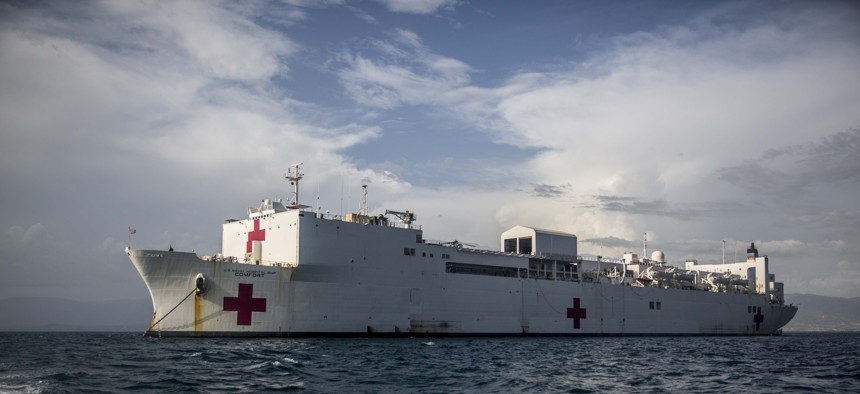
The USNS Comfort (T-AH-20) sits off the coast of Carrefour, Haiti, during Continuing Promise 15, Sept. 14, 2015. U.S. Marine Corps photo by Sgt. James R. Skelton
Cuban, US Ties Form Aboard US Military’s Hospital Ship
Thanks to the new open U.S. policy toward Cuba, the work done aboard the hospital ship USNS Comfort heals more than bodies.
On a sunny day in September, two medical teams—one American, one Cuban—came together to examine patients in a hospital in Haiti. In a historic moment, U.S. and Cuban doctors worked side-by-side, providing free care to ease the suffering of Haiti’s poor. This remarkable event was made possible by the presence of the U.S. Navy hospital ship USNS Comfort, anchored off the Haitian coast as part of the Continuing Promise 2015 mission, and by our new policy towards Cuba, which has created new opportunities for U.S. engagement in the region.
Navy doctors found great value in working alongside Cuban doctors at La Renaissance hospital, a Cuban medical site, and through a joint visit to St. Luc’s, in Port-Au-Prince. These exchanges allowed for collaboration and the sharing of best practices, in areas of pediatrics, general medicine, optometry, ophthalmology and general surgery. Participants found both Cuban and U.S. medical professionals share mutual goals for medical treatment.
Several days earlier, Cuban diplomats and medical officials toured the Comfort’s medical facilities and met with their U.S. counterparts. The entire experience was extremely positive for both sides, highlighting the strategic importance of U.S. engagement and the role of the Comfort in bringing people together for the common good.
The work done aboard the Comfort clearly heals more than bodies. It bridges gaps, builds ties, and makes history. As the U.S. military seeks to remain globally engaged in the face of declining resources, missions like Continuing Promise underscore the enduring value of humanitarian engagement, public-private partnerships, and forward presence in the Western Hemisphere. It is without a doubt one of the U.S. military’s most impactful missions.
Later that month, the crew of the Comfort returned home after a six-month deployment to 11 countries in Latin America and the Caribbean. Working with nearly 400 non-governmental organization, or NGO, volunteers, medical and support staff from across the U.S. military and the region treated 122,268 patients and conducted 1,255 surgeries, with an additional 279 life-changing operations as part of Operation Smile. Partnerships with NGOs and the private sector resulted in $3.78 million in donations to partner nations, including gifts-in-kind like medicine, wheelchairs, clothing, and high-nutrition meals. While ashore, the crew conducted 94 engineering projects, renovating public buildings, schools, and clinics in under-serviced, remote areas, and trained 894 partner nation civilian and military personnel, ensuring the mission’s impact will endure long after the ship departs. Additionally, Comfort personnel directly supported State Department and USAID’s developmental and social projects by improving water sanitation and providing healthcare to children affected by HIV/AIDS.
The Comfort’s deployment also highlighted deepening U.S. ties with the region. In terms of geographic proximity, trade, culture, demographics, and the environment, no other part of the world has greater impact on daily life in our country than Latin America and the Caribbean. As the Comfort transited through Central America, South America, and the Caribbean, it visited a region that is increasingly prosperous, peaceful, and home to millions of citizens who share our commitment to advancing democratic values and working together to ensure stability and security throughout the Western Hemisphere.
The Comfort is one of the greatest symbols of U.S. friendship with our neighbors. In an era when we must make each limited defense dollar count, missions like Continuing Promise are irreplaceable. They display the very best of who we are as a nation. They remind the world that the greatest strength of the United States is not the size of our military, but the compassion and kindness of our people. As one Latin American leader put it, “Your visit gives us a sense of hope that we are not alone.”
Perhaps this message of solidarity is the mission’s most enduring impact. It sends a simple and powerful signal to our friends in Latin America and the Caribbean: one of fellowship, partnership, and hope for the future.



